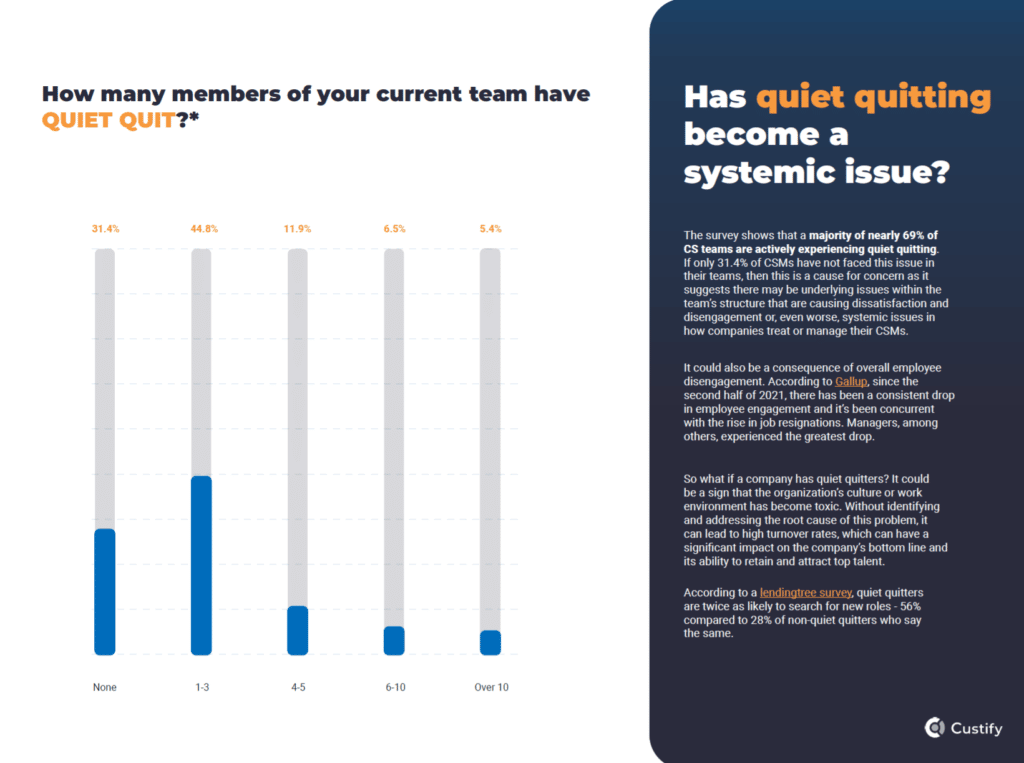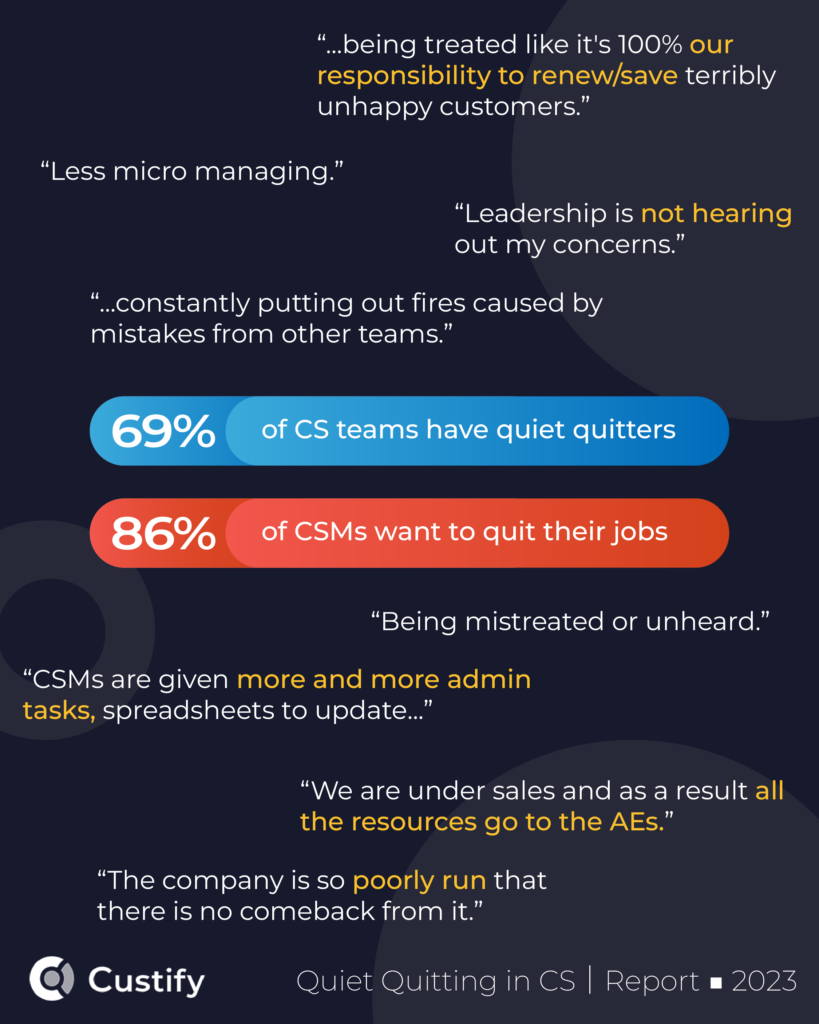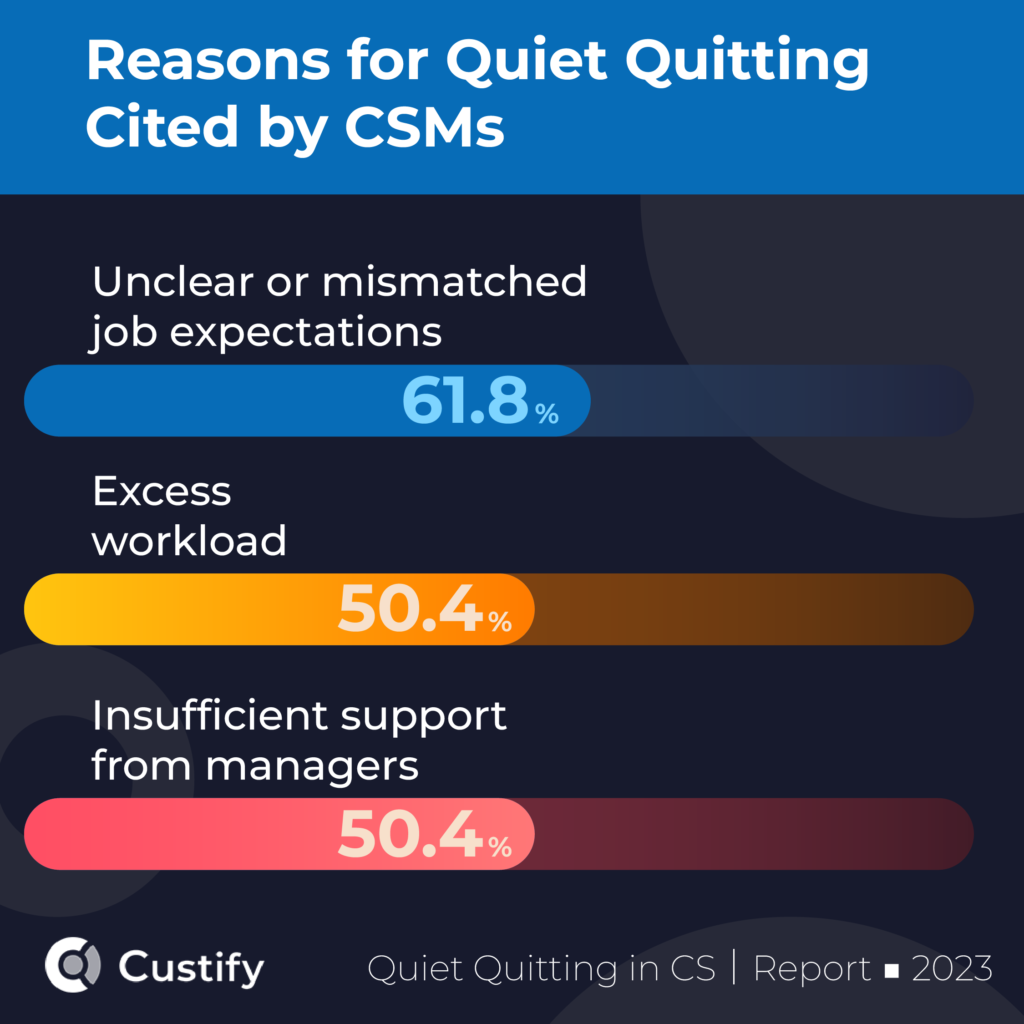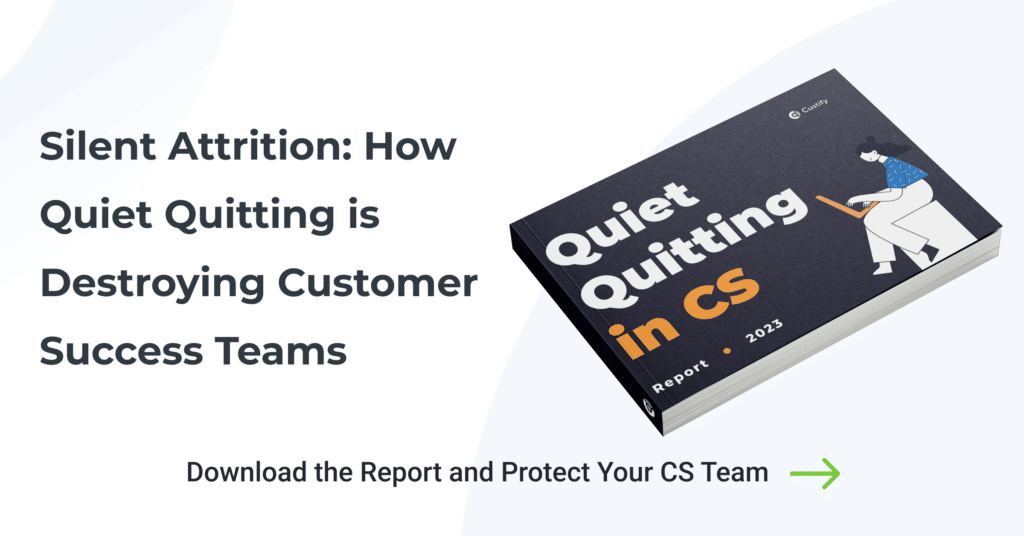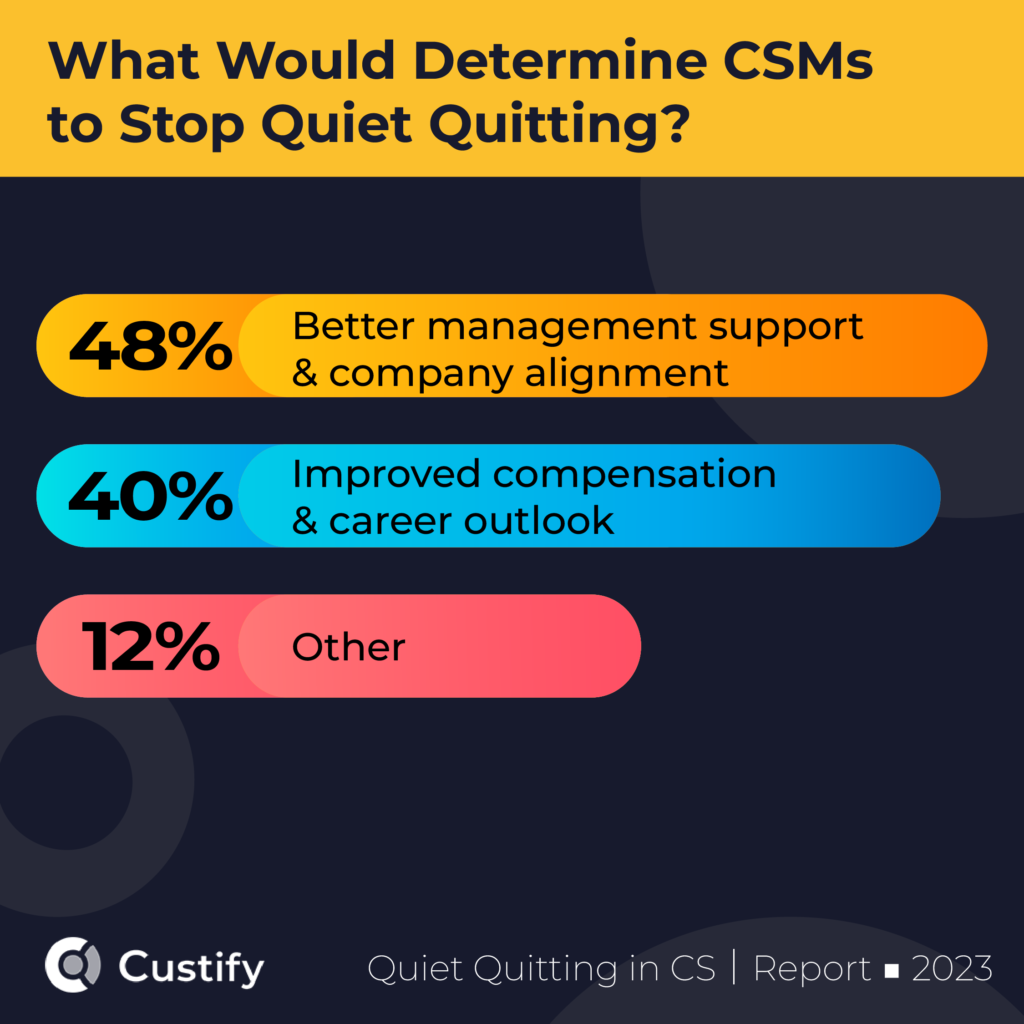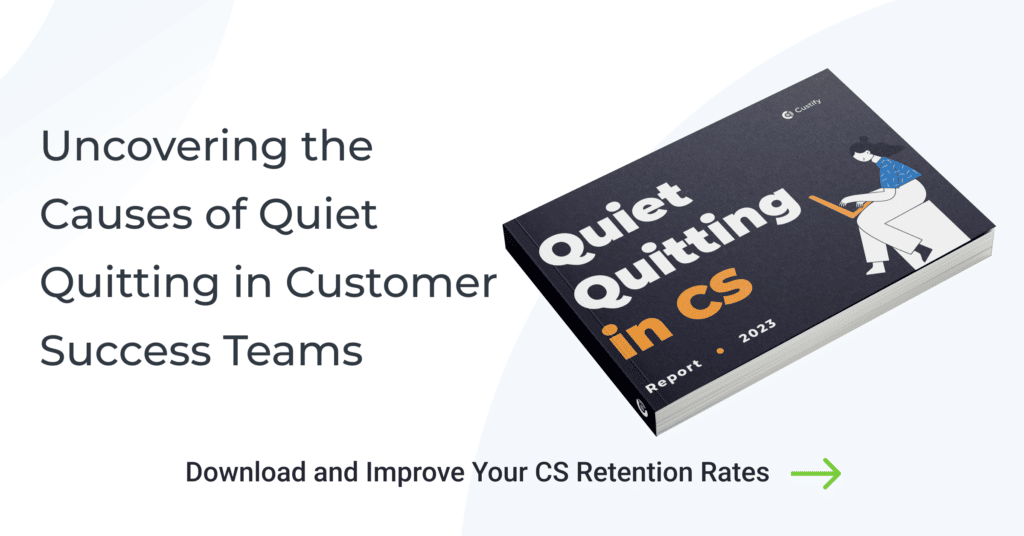About the 2023 Study on Quiet Quitting in CS
Welcome to our new survey on the state of customer success teams. In this study, we’ve surveyed over 570 CS professionals to gain insights into the challenges and difficulties they face every day. Our goal was to get an accurate understanding of how CS leaders and practitioners are adapting to new complex market conditions and customer expectations.
Our research reveals a disturbing trend: the majority of CS teams are actively dealing with “quiet quitting,” a phenomenon where staff members disengage from their workplace.
We’ve also discovered that many CS workers believe their company’s expectations are unclear or mismatched, and that management-related difficulties are a major cause for why many end up leaving their jobs.
With special contributions from Mohammed Alqaq, Rachel Provan, Shawn Riedel, Mikael Blaisdell, Philipp Wolf, Irina Vatafu and Lauren Locke-Paddon, this e-book goes into great detail about the problems CS teams are facing and offers practical advice in finding their solutions.
Who and Why should read this report?
This report is mainly about employee retention and employee satisfaction and is of high value to:
- CS Team Leaders, Managers and VPs.
- Anyone working in a customer success or customer experience team.
- HR professionals.
- Executives who are interested in retaining and developing their employees.
- Industry analysts or VCs looking for insights into the customer success sector.
- CEOs and CFOs looking to improve their employee retention as well as what to demand from their CS teams.
What you’ll learn from this report:
- The major reasons why CS teams quiet quit.
- The proportion of CS employees who have quiet quit or are seriously considering it.
- How compensation, career objectives, and management support affect quiet quitting.
- CS budget status across companies.
- The perception of CS as a source of income and growth in North America vs Europe.
- The job satisfaction of CS personnel in North America and Europe.
- Strategies and best practices to reduce quiet quitting and retain CS employees.
Key Findings from the survey
- Over 50% of customer success staff either quiet quit or are considering doing so because of workload, management-related difficulties, or lack of pay.
- Unclear or mismatched expectations are cited as the cause for over 62% of CS quiet quitters.
- 48% would stop quiet quitting if they had better management support.
- Businesses can dramatically reduce quiet quitting if they give greater management assistance and career plans a high priority.
- The majority of respondents (70%) reported having coworkers leave in the previous 12 months, but unexpectedly, senior employees made up the majority.
- 75% of companies from Europe and the Middle East consider CS a revenue and growth driver.
- CS employees in North America are 53% more likely than those in Europe to change jobs in the upcoming six months.
- Over 56% of CS/CX personnel state that customer support is part of their general responsibilities.
What is Quiet Quitting anyway?
Companies in all industries are being impacted by the phenomenon of quiet quitting, also referred to as “stealth quitting”. Employees disengage from their work and start to disengage from their workplace, frequently without giving their employer any indication that they are thinking about leaving. More specifically, they do their minimum job requirements and put in no more time or effort than absolutely necessary.
A recent Gallup study finds that at least 50% of American workers are “quiet quitters,” and the percentage is probably even higher. Also, new studies show that 57% of employees have considered quitting after taking a break.
The term “quiet quitting,” though not a novel idea, has recently acquired popularity on social media as some workers reject the hustle culture and establish strict boundaries. Sometimes they do this to improve work-life balance, but what we found is that many times the cause is workplace related.
According to Techtarget, these are some common signs of quiet quitting:
- not attending meetings.
- arriving late or leaving early.
- lowered productivity.
- lowered contribution to team projects.
- not actively participating in planning or meetings.
- lack of passion or enthusiasm.
Why quiet quitting is a problem for CS
Contrary to popular belief, quiet quitting is not just an issue for companies that are downsizing. In fact, this survey found that it’s a good sign of deep problems within the organization.
SaaS companies in particular rely heavily on their employees to drive innovation and growth. When they disengage, they are less productive and less motivated, which can lead to a decrease in overall productivity and a decline in the quality of work. This will eventually lead to a loss of valuable talent, as disengaged employees are more likely to leave.
Customer success is a business function that’s founded on positive outcomes. CSMs work proactively to help their customers grow and better adopt their product. A disengaged employee here will have a significant impact across the entire team. So for this reason we asked ourselves how much are CSMs quiet quitting, and why? This PDF is the answer.
Expert insights on preventing or reversing quiet quitting
We asked experts across the industry how they see quiet quitting and the stats from this survey. Is customer success poorly defined in some companies, are employees demanding too much, or do CEOs and managers have unrealistic expectations?
These are some of the insights that can be found in the full PDF ebook:
I’d say it’s a combination of factors. Despite so many people outside of CS saying that it’s unclear and not well defined yet, this isn’t the case. It is very well defined, but that understanding hasn’t been able to break out of the echo chamber of the CS community. Most CEOs especially do not understand CS, so it becomes a miscellaneous department.
This can lead to unrealistic expectations and burnout for CSMs, who are often asked to handle a wide range of tasks including documentation, inter-department communication, upsells, product marketing, trainings, and more. Because Customer Success doesn’t have strong boundaries, if there’s something that has to do with the customer, it gets kicked over to the CSMs.
Rachel Provan – CS Leadership Coach | Top 50 Women Leaders In CS 2022 | Top 100 CS Strategist 2022 | Founder – Provan Success, LLC
For me, a lack of career growth opportunities could be the cause of high job retention challenges in CS and a higher number of senior people quitting. Senior team members are frequently looking for new challenges and opportunities for professional development, and if they believe they’ve reached a plateau in their current position, they may choose to leave for a company that can provide them with more opportunities for advancement.
This is a common problem in many businesses, and it can be solved by implementing a clear career progression plan for each team member and providing regular training and development opportunities to help them grow and evolve in their role.Sunny Kumar – Founder & Marketing Specialist, TheWPX
Burnout is often the result of an overwhelming workload and an excessive number of responsibilities and tasks assigned to CSMs. To prevent this, organizations should review the size of their CSMs’ book of business and identify tasks that can be automated to reduce workload and prevent burnout.
Erin Estabaya – Customer Success Manager, Kula
Unrealistic expectations placed on CS is a key factor in high rates of burnout and disengagement among CSMs. As a newer field, CS is still developing and maturing, and it is important for organizations to recognize that and adjust their expectations accordingly. This includes differentiating CS roles from sales and support, and understanding that the field is still evolving.
Eric Minish – Customer Success Operations Manager, Transactly
The work of a CSM can be endless and hard. I’m filling in right now, and if you don’t have good processes, tools, and support, they could be drowning. Might be ripe for an open dialogue with the team to find out what they need to feel supported.
Keishla Ceaser-Jones – Senior Director, Partner Success, EAB
As a CS leader, it’s crucial to place customer retention at the forefront of your priorities. In this recession-focused context, winning companies understand the importance of dedicating resources and adjusting their strategies towards retaining customers and minimizing churn.
This shift in focus from new sales to customer retention is essential for several reasons. In today’s challenging economic climate, budgets across most departments are being reduced, and companies are looking to cut costs. Sales and marketing will have a harder time but CS has an opportunity to make the case for extra funds. It owns retention and in this difficult market, that’s the best way to protect their revenue streams and maximize customer lifetime value.
Irina Vatafu – Lead Customer Success Manager, Custify
How to get the quiet quitting survey PDF?
The above are some of the insights that we’ve prepared for you as part of this survey. Get the full statistics, responses and opinions by downloading the ebook pdf for free.
Conclusion
This survey highlights critical issues that are driving customer success teams to experience quiet quitting. Some of the statistics are quite worrying. The silver lining is that nearly 50% of quiet quitters would reconsider if they had some of their basic requests met. It’s up to each company how they take this data. Next year we look forward to analyzing if the trend goes down or up.
The vital meaning in the current employment uncertainty is that Customer Success has a perception problem that needs to be seriously addressed. So long as the Board and Senior Management do not perceive Customer Success to be necessary to protect strategically significant levels of income and profitability for the company, the CS group and its members are at-risk of losing their jobs. The direct connection between Customer Success and profitability cannot be assumed, it must be clearly proven to all on an ongoing basis.
Mikael Blaisdell – Analyst. Advisor. Executive Director – The Customer Success Association


